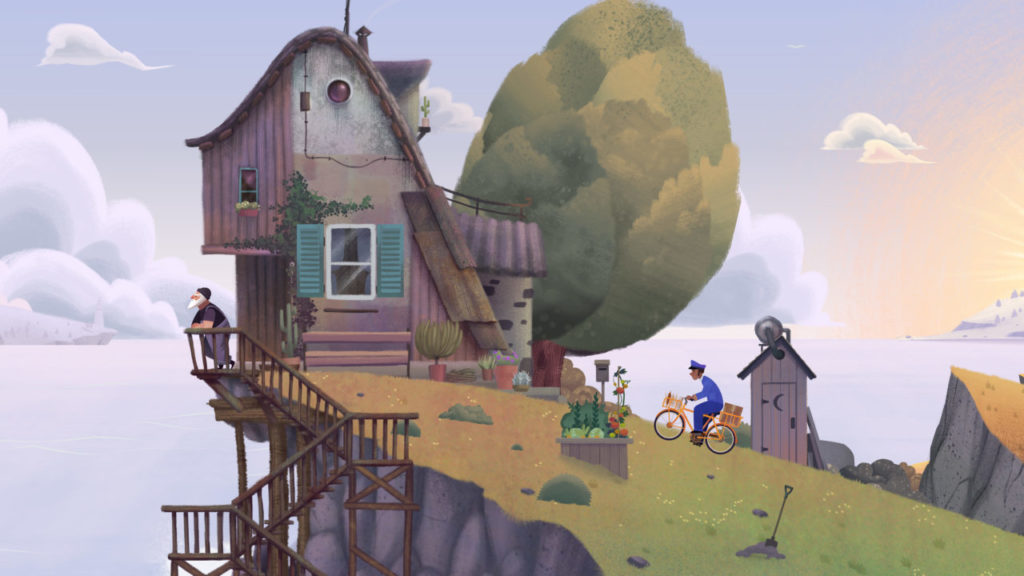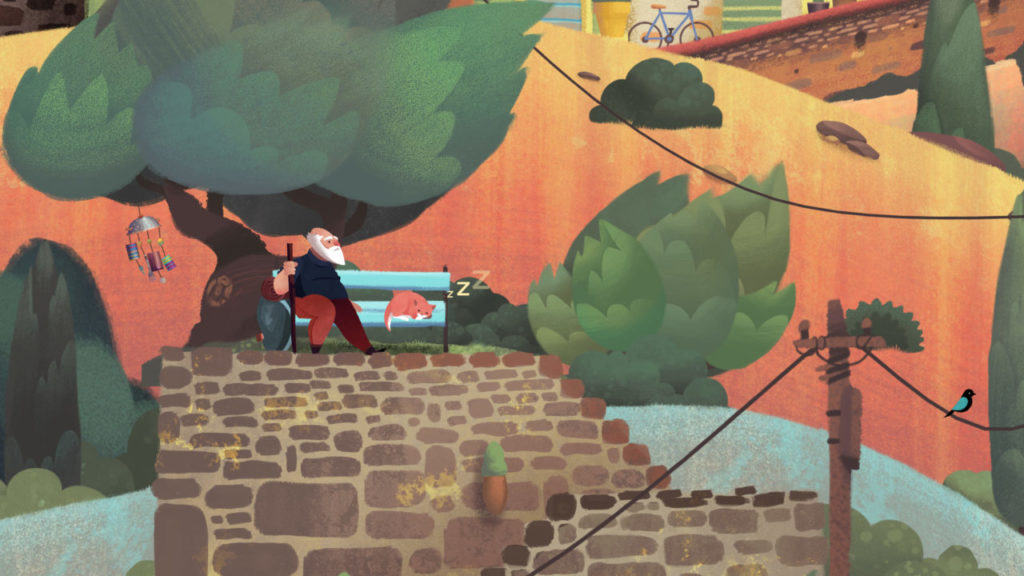Old Man’s Journey is a simple yet compelling drag-and-drop adventure about an old man who hastily leaves his coastal home and travels the breadth of France after receiving a letter in the post. Along the way the Old Man will reminisce about his past; rediscovering his passions, the friends he loved, and the people he lost.
From the get-go it’s evident that Old Man’s Journey is optimised for mobile devices and touch screens so it was a shame the Dualshock’s touchpad wasn’t taken advantage of, and although this may sound like a negative to start on it’s worth reassuring you that using a thumbstick gets the job done just as well. Old Man’s Journey has two controls: use the left stick to move a cursor and use the X button to interact with the world or to make the Old Man walk.

Gameplay is extremely simple, intuitive and isn’t burdened by the complexity of control other games might force upon a player. Click on the world and the Old Man will walk there but pushing him on his way isn’t always enough; In order for the Old Man to get where he is going you’re responsible for creating a path for him to follow. You do this by dragging-and-dropping the landscape, usually connecting the foreground with the background, until the Old Man has a route he can take. Rather than getting the Old Man from one end of the screen to the other you’ll find yourself going into the game – It’s as if you’re peeling back layers of a painting and pulling what’s underneath towards you.

It isn’t a complicated or difficult game but it’s not supposed to be. There are more puzzle elements introduced later on that keep you on your toes and force you to re-evaluate your understanding of the shifting landscape, and there are moments that test your perception of a three-dimensional character trapped in a two-dimensional world, but you won’t find yourself craving a challenge because your priority will be unlocking more of the Old Man’s memories and finding out where his journey ends.
Old Man’s Journey is like watching a living painting; you can actually see the brush strokes shimmering when things move. Sometimes it’s like playing with a diorama; trees that look like cardboard cut-outs will sway in the wind and flat sheep will run away when you click on them. The colours on show instantly transport you to your favourite holiday where the sun is high, the sand is warm and everything seems at peace. Even in the wet, rainy levels the yellows, oranges and greens manage to squeeze themselves through the ambush of grey.

Broken Rules should be proud of Old Man’s Journey because it is a shining example of the true diversity that can be found in videogames. It’s the perfect game to demonstrate to the naysayers that games aren’t all about mindless acts of violence. It’s a lovely introduction to gaming and the perfect game for parents to play with their young ones. Although the story might be too emotionally sophisticated for children to fully digest, the Parisian music – which is a soft angelic composition of harmonica, accordion and piano – paint brush art style and colourful pallet will keep them engaged enough to learn simple gameplay mechanics.

As the story is at the heart of Old Man’s Journey I would hate to ruin it for you. The most I’m willing to say is that the Old Man’s trek across France isn’t only a step towards his future but it’s also a retreading of his past, and Broken Rules have gelled the two seamlessly together. I genuinely think Old Man’s Journey will mean one thing to you now and will mean something completely different if you played it again 30 years later, and that’s not a feat games usually achieve.
VERDICT
Should you play it? Yes
Why? It’s easy to play, it’s relaxing to play and it’s emotional to play. It’s beautiful to look at and it’s therapeutic to listen to.
But… It feels like a mobile game. It’s not off-putting but it is obvious, especially when certain levels ask for pinpoint accuracy – something a finger on a small screen is much more capable of doing.
Reviewed on PlayStation 4. Review code supplied by Broken Rules.








